Related Research Articles
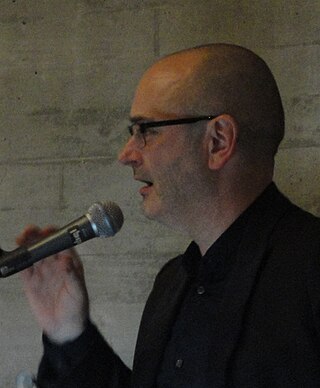
Douglas Gordon is a Scottish artist. He won the Turner Prize in 1996, the Premio 2000 at the 47th Venice Biennale in 1997 and the Hugo Boss Prize in 1998. He lives and works in Berlin, Germany.
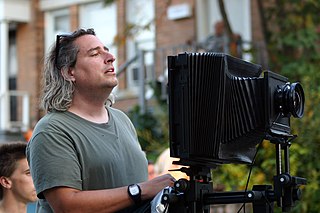
Gregory Crewdson is an American photographer who makes large-scale, cinematic, psychologically-charged prints of staged scenes set in suburban landscapes and interiors. He directs a large production and lighting crew to construct his images.
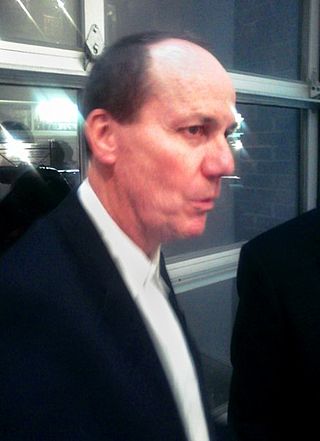
Richard Prince is an American painter and photographer. In the mid-1970s, Prince made drawings and painterly collages that he has since disowned. His image, Untitled (Cowboy), a photographic reproduction of a photograph by Sam Abell and appropriated from a cigarette advertisement, was the first rephotograph to be sold for more than $1 million at auction at Christie's New York in 2005. He is regarded as "one of the most revered artists of his generation" according to The New York Times.
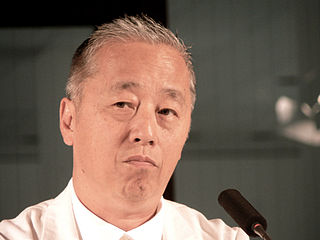
Hiroshi Sugimoto is a Japanese photographer and architect. He leads the Tokyo-based architectural firm New Material Research Laboratory.
Edward Joseph Ruscha IV is an American artist associated with the pop art movement. He has worked in the media of painting, printmaking, drawing, photography, and film. He is also noted for creating several artist's books. Ruscha lives and works in Culver City, California.
Jennifer Anne Saville is a contemporary British painter and an original member of the Young British Artists. Saville works and lives in Oxford, England and she is known for her large-scale painted depictions of nude women. Saville has been credited with originating a new and challenging method of painting the female nude and reinventing figure painting for contemporary art. Some paintings are of small dimensions, while other are of much larger scale. Monumental subjects come from pathology textbooks that she has studied that informed her on injury to bruise, burns, and deformity. John Gray commented: "As I see it, Jenny Saville's work expresses a parallel project of reclaiming the body from personality. Saville worked with many models who under went cosmetic surgery to reshape a portion of their body. In doing that, she captures "marks of personality for the flesh" and together embraces how we can be the writers of our own lives."

John Currin is an American painter based in New York City. He is most recognised for his technically proficient satirical figurative paintings that explore controversial sexual and societal topics. His work shows a wide range of influences, including sources as diverse as the Renaissance, popular culture magazines, and contemporary fashion models. He often distorts or exaggerates the erotic forms of the female body, and has stressed that his characters are reflections of himself rather than inspired by real people.
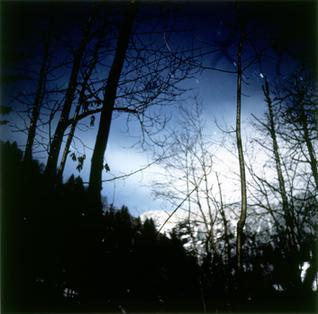
Darren James Almond is an English artist, based in London. He was nominated for the 2005 Turner Prize.
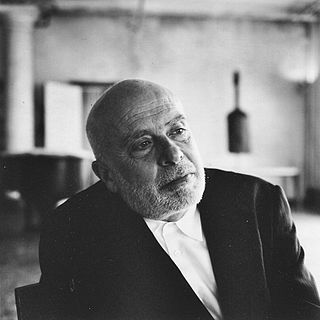
Francesco Clemente is an Italian contemporary artist and book publisher. He has lived and worked at various times in Italy, India and New York City. Some of his work is influenced by the traditional art and culture of India. He has worked in various artistic media including drawing, fresco, graphics, mosaic, oils and sculpture. He was among the principal figures in the Italian Transavanguardia movement of the 1980s, which was characterized by a rejection of Formalism and conceptual art and a return to figurative art and Symbolism. He was the co-publisher of Hanuman Books from 1986 to 1993.

Kenny Scharf is an American painter known for his participation in New York City's interdisciplinary East Village art scene during the 1980s, alongside Jean-Michel Basquiat and Keith Haring. Scharf's do-it-yourself practice spanned painting, sculpture, fashion, video, performance art, and street art. Growing up in post-World War II Southern California, Scharf was fascinated by television and the futuristic promise of modern design. His works often includes pop culture icons, such as the Flintstones and the Jetsons, or caricatures of middle-class Americans in an apocalyptic science fiction setting.
Albert Oehlen is a German artist and musician. He lives and works in Bühler, Switzerland and Segovia, Spain.
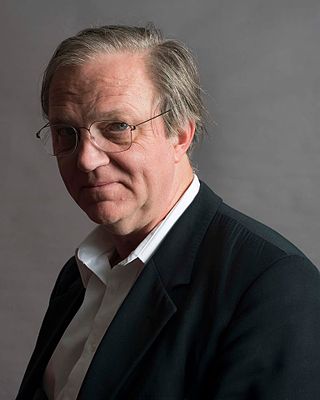
Robert Storr is an American curator, critic, painter, and writer.
Urs Fischer is a Swiss-born contemporary visual artist living in New York City and Los Angeles. Fischer’s practice includes sculpture, installation, photography, and digitally-mediated images.
Joe Bradley is an American visual artist, known for his minimalist and color field paintings. He is also the former lead singer of the punk band Cheeseburger. Bradley has been based in New York City and Amagansett.
Piero Golia is a conceptual artist based in Los Angeles.
Adriana Varejão is a Brazilian artist. She works in various disciplines including painting, drawing, sculpture, installation and photography. She was an artist-in-resident at the Isabella Stewart Gardner Museum in 2004. Varejão lives and works in Rio de Janeiro.

Duke Riley is an American artist. Riley earned a BFA in painting from the Rhode Island School of Design, and a MFA in Sculpture from the Pratt Institute. He lives in Brooklyn, New York. He is noted for a body of work incorporating the seafarer's craft with nautical history, as well as the host of a series of illegal clambakes on the Brooklyn waterfront for the New York artistic community. Riley told the Village Voice that he has "always been interested in the space where water meets land in the urban landscape."
Gary Schneider is a South African-born American photographer known for his portraiture and self-portraits. According to the John Simon Guggenheim Memorial Foundation, which awarded him a Guggenheim Fellowship in 2013, his "early work in painting, performance, and film remain integral to his explorations of portraiture. He strives to marry art and science, identity and obscurity, figuration and abstraction, the carnal and the spiritual."
Vera Lutter is a German artist based in New York City. She works with several forms of digital media, including photography, projections, and video-sound installations. Through a multitude of processes, Lutter's oeuvre focuses on light and its ability to articulate the passing time and movement within a tangible image.

Piotr Uklański is a contemporary Polish-American artist who has produced art since the mid 1990s which have explored themes of spectacle, cliche, and tropes of modern art. Many of his pieces and projects take well-known, overused, sometimes sentimental subjects and tropes and both embraces and subverts them. Untitled (1996) is one of his best known works which took a minimalist grid floor in the gallery and developed it into a disco dance floor activated with sound and lit with bright colors. His works have been featured at the Museum of Modern Art in New York, Migros Museum of Contemporary Art in Zurich, Museum of Modern and Contemporary Art in Strasbourg, and Whitney Museum of American Art in New York.
References
- ↑ Koroxenidis, Alexandra (13 November 2009). "Art with a spiritual subtext" (PDF). Athens Plus. The International Herald Tribune & Kathimerini SA. p. 27. Retrieved 29 May 2014.
- ↑ Storr, Robert (27 June 2019). Y.Z. Kami. Skira. ISBN 9788857239392 . Retrieved 23 October 2018.
- ↑ Bousteau, Fabrice. YZ Kami, Peinture et infini. Beaux Arts, Jan 2009, p. 68.
- 1 2 Interview with Y.Z. Kami / Ziba de Weck Ardalan, Y.Z. Kami. Y.Z. Kami: Endless Prayers. London: Parasol Unit/Koenig Books, 2008), p. 38.
- 1 2 "Y.Z. Kami – Exhibitions – John Berggruen Gallery". Archived from the original on 2016-03-05. Retrieved 2016-02-25.
- ↑ Interview with Y.Z. Kami / Ziba de Weck Ardalan, Y.Z. Kami. Y.Z. Kami: Endless Prayers. London: Parasol Unit/Koenig Books, 2008), p. 39.
- ↑ Richard, Paul. Kami's 'Perspectives': A State of Being that Transcends Cultural Boundaries. The Washington Post, April 22, 2008.
- 1 2 "Y.Z. Kami – Q&A – Gagosian Gallery". 26 May 2015. Archived from the original on 2016-03-05. Retrieved 2016-02-25.
- ↑ "Y.Z. Kami". Artsy. Archived from the original on 2018-10-24. Retrieved 2018-10-24.
- ↑ The Art Channel (7 May 2015). "Paintings by Y.Z.Kami at Gagosian Gallery, Britannia Street, London". Archived from the original on 2015-08-27. Retrieved 2016-02-25– via YouTube.
- ↑ "Google". www.gagosian.com. 26 May 2015. Archived from the original on 2016-03-05. Retrieved 2016-02-25.
- ↑ Wyndham, Samantha. The Eloquent Philosopher YZ Kami. Canvas Mag Vol. 5 Issue 3 May/June 2009, p. 111.
- ↑ "90. Y.Z. Kami. Self-portrait as a Child". Phillips. Archived from the original on 2018-10-24. Retrieved 2018-10-24.
- ↑ "Y.Z. Kami. UNTITLED. 1997". Archived from the original on 2018-10-24. Retrieved 24 October 2018.
- ↑ Johnson, Ken (31 March 2000). "ART IN REVIEW; 'Invitational Exhibition'". The New York Times. Archived from the original on 2018-10-24. Retrieved 23 October 2018.
- 1 2 Robert Storr, "Every Time I Feel the Spirit," in Y.Z. Kami: Paintings (New York: Gagosian Gallery, 2014), p. 26.
- ↑ Steven Henry Madoff, "Y.Z. Kami and the Fact of Mere Being," in Y.Z. Kami (New York: Gagosian Gallery, 2008, p. 65)
- ↑ Robert Storr, YZ Kami cataogue 2014
- ↑ Wullschlager, Jackie (3 April 2015). "Y Z Kami, Gagosian Gallery, London" – via Financial Times.
- ↑ Cumming, Laura (12 April 2015). "YZ Kami: Paintings review – making visible the invisible". The Observer. Archived from the original on 2017-02-10. Retrieved 2016-12-13.
- ↑ Villarreal, Ignacio. "Y.Z. Kami – Endless Prayers at Parasol Unit Foundation for Contemporary Art". Archived from the original on 2016-10-11. Retrieved 2016-02-25.
- ↑ Richard, Paul (22 April 2008). "Kami's 'Perspectives': A State of Being That Transcends Cultural Boundaries". Archived from the original on 2018-10-24. Retrieved 2017-12-03– via washingtonpost.com.
- ↑ "Y.Z. Kami – Listed Exhibitions" (PDF). Archived (PDF) from the original on 2018-10-24. Retrieved 2018-10-24.
- ↑ "Google". gagosian.com. 26 May 2015. Archived from the original on 2018-10-24. Retrieved 2018-10-24.
- ↑ "Y.Z. Kami: Night Paintings". gagosian.com. 3 December 2019. Retrieved 2023-11-28.
- ↑ "MUSAC".
- ↑ "2020 Y.Z. Kami: Night Paintings. Gagosian Gallery, Rome, Italy". 3 December 2019.
- ↑ "2018 Y.Z. Kami: Geometry of Light. Gagosian Gallery, Paris, France". 12 April 2018.
- ↑ "2016–17 Y.Z. Kami: Endless Prayers. Los Angeles County Museum of Art (LACMA), Los Angeles, CA". Archived from the original on 2017-05-19.
- ↑ "Y.Z. Kami – April 9 – May 30, 2015 – Gagosian Gallery". Archived from the original on 2016-03-04. Retrieved 2016-02-25.
- ↑ "Y.Z. Kami – January 16 – February 22, 2014 – Gagosian Gallery". Archived from the original on 2014-01-10. Retrieved 2014-01-21.
- ↑ "Y.Z. Kami: 'Endless Prayers'21 November 2008 – 11 February 2009 – Parasol Unit". Archived from the original on 2015-04-16. Retrieved 2014-06-03.
- ↑ "Y.Z. Kami – January 8 – February 14, 2008 – Gagosian Gallery". Archived from the original on 2016-03-04. Retrieved 2016-02-26.